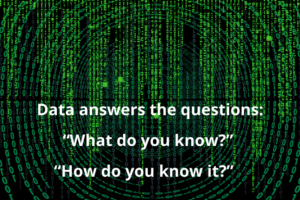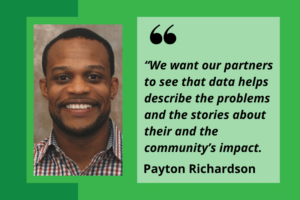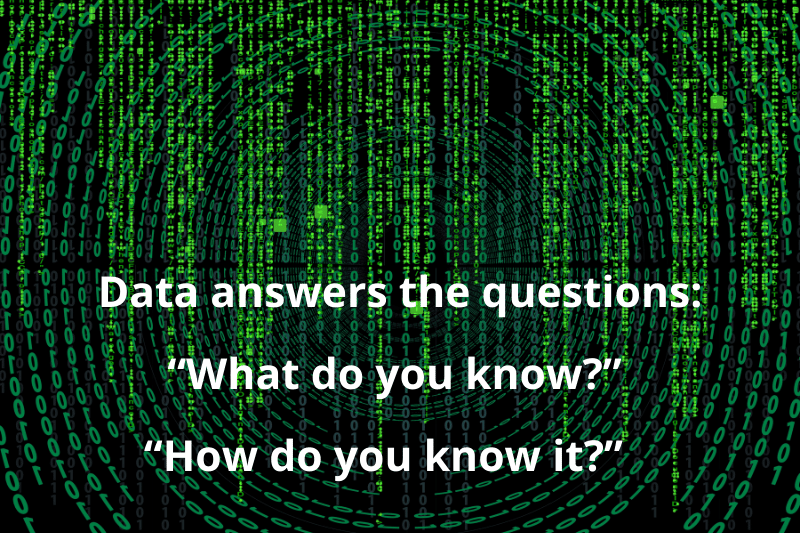When you work in the social services sector, you hear a lot of compelling stories of real people who’ve encountered adversity and then found relief or support to find a route for success. Those are the types of stories that we deploy to tug on funders’ heartstrings, while we say, “that’s why I do this work.”
 For Eastside Pathways, such guideposts are aggregated into six essential goals – statements that reflect our collective aspirational and intentional hopes for children, youth, young adults, families and community. But come down from the loftiness of those visions, and what else knits the Partnership together? It’s data. If the goals are the “how” we do this work, data answers the questions, “what do you know?” and “how do you know it?”
For Eastside Pathways, such guideposts are aggregated into six essential goals – statements that reflect our collective aspirational and intentional hopes for children, youth, young adults, families and community. But come down from the loftiness of those visions, and what else knits the Partnership together? It’s data. If the goals are the “how” we do this work, data answers the questions, “what do you know?” and “how do you know it?”
Critically, data helps collective impact initiatives stay on track and aligned to common goals established by the collaborators. Without data or proper interpretation, stakeholders may be attached to a false narrative. But good data can shift the narrative, challenge assumptions and create the will to change. For example, to get an overview of the education landscape, we rely on regularly tracked indicators: enrollment, graduation rates, standardized test scores, etc. When those indicators are disaggregated – broken down – by factors such as race/ethnicity, ZIP code, or gender, it can clarify opportunities to make progress towards the aspirational goals via targeted approaches (see Targeted Universalism).
Data Sharing across the Partnership yields benefits for all
Some of the larger Eastside Pathways organizational partners, such as school districts and municipalities, have tremendous data capacities: they have staff (statisticians, demographers, researchers) whose job is to collect and analyze data, design collection methodologies, and evaluate programs. The volume, type, and quality of available data is enough to inform decisions just within their own scope of service. On the other hand, smaller or community-based organizations devote their resources primarily towards service delivery – often with little left over for data practices, even though their population-specific focus means that they are sensitive to the effects of program modifications.
Large organizations that keep data to themselves, or small organizations which may have limited choice, may inadvertently be left without the full landscape of information to address issues in the larger community and what happens to their focus population as it moves through the age continuum. But in a collective impact partnership like Eastside Pathways, organizations of all sectors and sizes have something to gain from each other.
Interviews conducted in 2017 by the Promotores Project established by Eastside Pathways found that families requested better access to information and critical services. Meanwhile, the Bellevue and Lake Washington school districts reported more data on a stubborn trend: In the fall of 2021, 39% of Latine children were assessed as meeting the six domains of Kindergarten Readiness, compared to 63% across the districts.
“The data on the current landscape was the impetus for a change in practice,” says Eastside Pathways Data Officer Payton Richardson. From there, the Early Learning CAN designed a program in which a group of promotores – the Spanish-speaking community volunteers who had helped identify the opportunities for better information access – were then trained to provide parents of Latine preschoolers with information about early childhood education and tools for self-advocacy and agency – all known predictors of early school success.
 Social science requires patience; there is a lag time between when a program is instituted and a measurable difference in impact. Fortunately, if the program is designed with a valid theory of action, then process measurement can track how much work is being done, and how well the program is being put into place, long before it’s possible to see whether the program actually moves the needle. So when it rolled out the new plan, NISO Programs, an Eastside Pathways Partner and the coordinator of the promotores, was advised by Eastside Pathways to take process measurements, such as the number of visits made by promotores, hours of training, and regularity of the participation.
Social science requires patience; there is a lag time between when a program is instituted and a measurable difference in impact. Fortunately, if the program is designed with a valid theory of action, then process measurement can track how much work is being done, and how well the program is being put into place, long before it’s possible to see whether the program actually moves the needle. So when it rolled out the new plan, NISO Programs, an Eastside Pathways Partner and the coordinator of the promotores, was advised by Eastside Pathways to take process measurements, such as the number of visits made by promotores, hours of training, and regularity of the participation.
“Before this, I didn’t know much about process evaluation,” says NISO’s founder Alma Gonzalez. “By participating with this Eastside Pathways initiative, I understand how much more complete our story is because we have data to back it up. It’s helped us plan and secure funding for what’s next.” She adds, “And I’m very glad to share that information back to big organizations.”
Bellevue School District’s Research Scientist Anna Van Windekens agrees: Community organizations “help us understand so much more about the community that we don’t have access to. We had a meeting recently with the people from YES (Youth Eastside Services)… it’s so cool to learn about all of their first-hand knowledge of these families, mostly Latinx* families at Sammamish High School. I would share things from a research point of view, and they would back that up with ‘Yeah! These home visits are totally in line with that!’ or, ‘The focus groups we did last year show that too.’ It helped me realize that I bring this perspective and they bring that perspective, and we find the reality in the middle. I feel like we gained so much from interacting with those groups. That makes our data and research work stronger.”
Enhancing the entire Partnership’s data literacy
 Richardson certainly hopes to see more robust sharing of information among Partners, provided all parties are thoughtful about what data is available and agree upon how it should be protected and used / interpreted. “We want our partners to see that data helps describe the problems and the stories about their and the community’s impact. Data can be more powerful when the limitations are addressed head on. It shows pragmatism and sets expectations at a reasonable level. And that inspires confidence in the work.”
Richardson certainly hopes to see more robust sharing of information among Partners, provided all parties are thoughtful about what data is available and agree upon how it should be protected and used / interpreted. “We want our partners to see that data helps describe the problems and the stories about their and the community’s impact. Data can be more powerful when the limitations are addressed head on. It shows pragmatism and sets expectations at a reasonable level. And that inspires confidence in the work.”
Improving data literacy, individually and collectively, has been identified as a goal of Eastside Pathways Partnership. Indeed, data literacy is an indicator of the state of the Partnership in general, one that will enable it to confidently answer the key question asked in the Strategic Plan, “How will we know we are making progress both collectively and in our organizations?”
As a benchmark, Eastside Pathways uses results of a 2021 partner survey which revealed opportunities to address how data is shared and utilized, especially for the dozen or so organizational partners who reported low/no data capacity. And early in 2023, Partners can expect to receive a follow-up survey to assess their access to data, as well as their capability and capacity to engage with it.
“We’re relying on Partners to tell us honestly what they need and want … that information will make for reliable data for our data capacity survey,” muses Richardson. He will analyze the results with the guidance of the Eastside Pathways Data Council, a team of Partners who have expertise in program evaluation and analysis. Already, the Council is discussing how to best match partner organizations’ data needs with opportunities to learn (perhaps training modules) – on how to use information, design programs and measure change.
As the Eastside Pathways Backbone prepares to support the data needs of the CANs and Partners, it also plans to use the data for continuous improvement of the Partnership as a whole: Do Partners represent the sectors that serve children and youth? Are Partners “showing up” and engaged? Are they working collaboratively and using information appropriately? The answers to those questions can reveal ways to make a bigger, more measurable impact for improved outcomes for children, youth, and young adults in East King County.
*Note: Eastside Pathways uses the term ‘Latine’
Email info@eastsidepathways.org to share comments or for more information.
Our next blog will about “How data informs continuous improvement and small test of change theory: Plan Do Study Act”

